The AMD Radeon R9 380X Review, Feat. ASUS STRIX
by Ryan Smith on November 23, 2015 8:30 AM EST- Posted in
- GPUs
- AMD
- Radeon
- Asus
- Radeon 300
Overclocking
Finally, no review of a video card would be complete without a look at overclocking performance.
With ASUS setting the STRIX R9 380X’s factory clockspeed to 1030MHz – 60MHz ahead of AMD’s reference clock of 970MHz – ASUS is already significantly eating into the headroom available on the card, and the 1050MHz OC mode further cuts into that. We don’t have any voltage control (we can’t even read the voltage) so the card can only be overclocked as far as the Tonga GPU can go on default voltage. Meanwhile ASUS hasn’t touched the memory clockspeed at all, which should mean there’s a bit more headroom there to play with.
| ASIS STRIX R9 380X Overclocking | ||||
| ASUS STRIX R9 380X OC (Stock) | ASUS STRIX R9 380X (OC) | |||
| Boost Clock | 1030MHz | 1100MHz | ||
| Memory Clock | 5.7Gbps | 6.4Gbps | ||
| Power Limit | 100% | 115% | ||
Ultimately we were able to push the STRIX R9 380X OC from 1030MHz to 1100MHz on the GPU, a 70MHz (7%) overclock. I fully expect that Tonga could do better with more voltage – and the ASUS cooler could keep up – but at the same time it would take a bad power efficiency situation and make it worse. Otherwise memory overclocking was a bit more fruitful, as we were able to push the card from 5.7Gbps to 6.4Gbps, a 700Mbps (12%) performance increase. Note that relative to the original 7970, the R9 380X has a narrower 256-bit memory bus, so if there are any situations where GCN 1.2’s color compression technology can’t make up the difference, a memory overclock may help to close the gap.
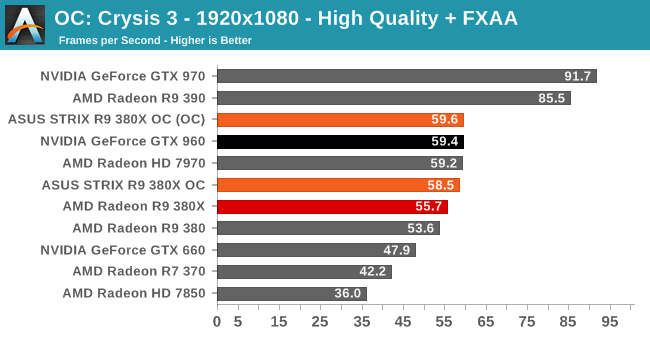
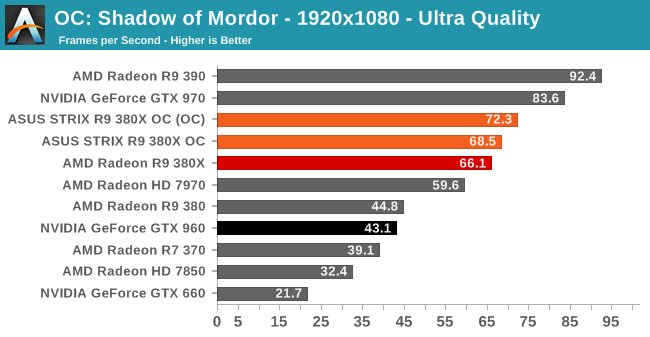
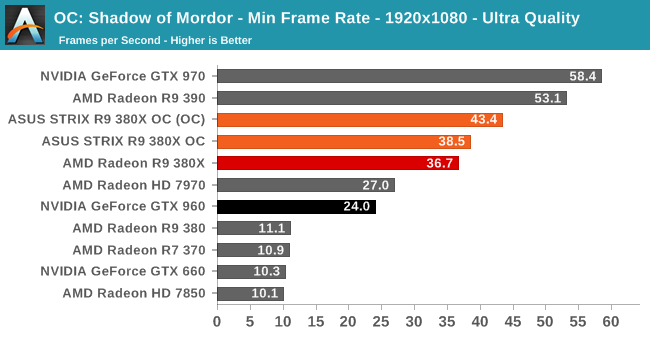
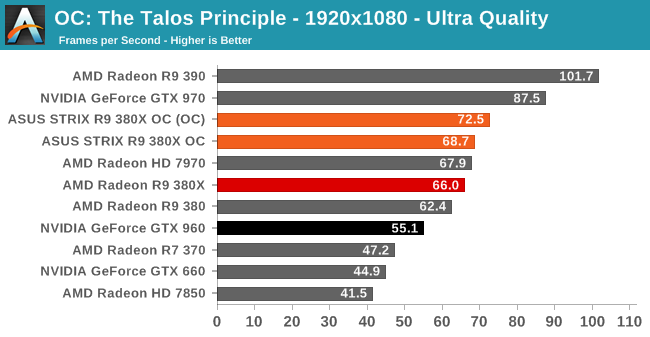
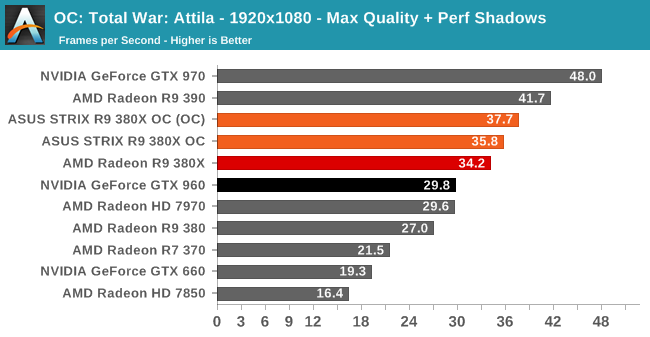
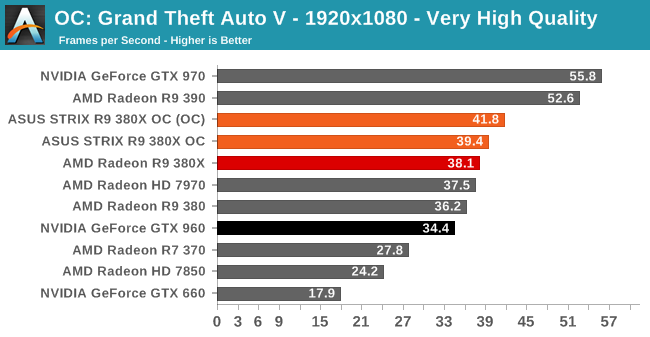
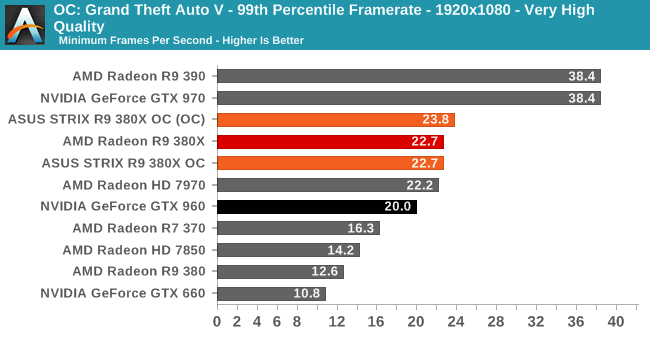
Overall overclocking is good for another 5% performance increase over the STRIX R9 380X's factory overclock. Though enough to be significant, as we guessed base upon the clockspeeds, ASUS has already tapped much of the overclocking headroom available on the card. For reference clocked cards on the other hand, assuming that they can overclock similarly well, this means they can look forward to a total of 10% or so from overclocking.
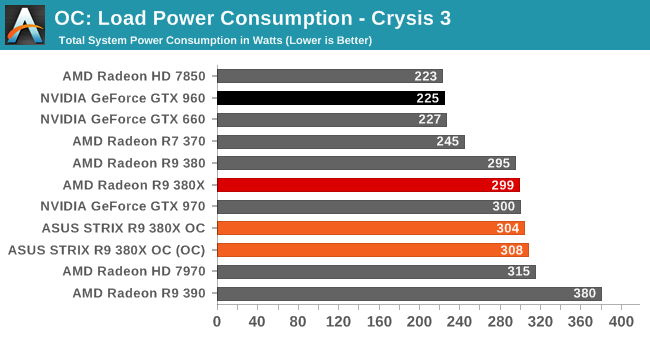
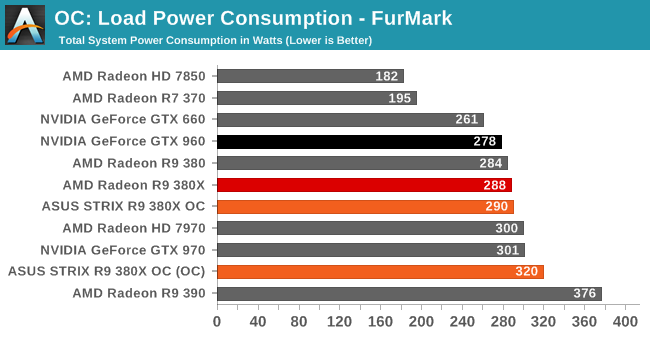
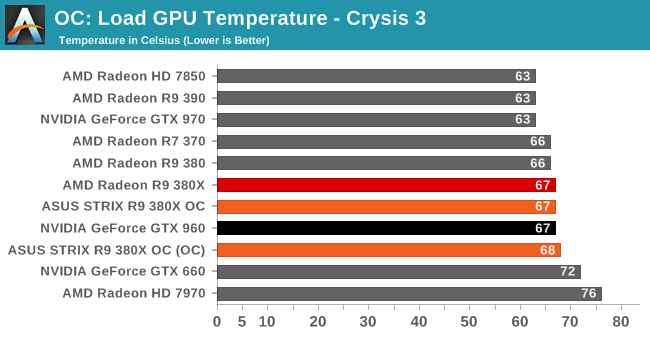
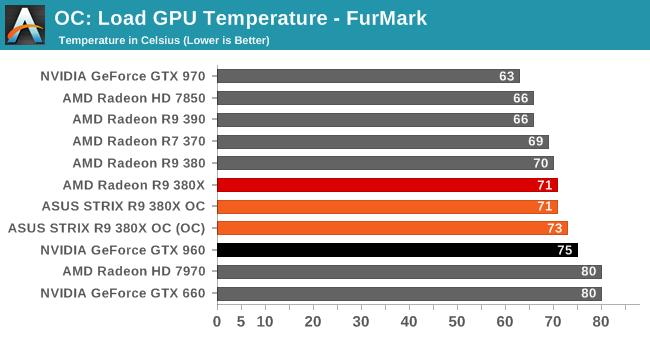
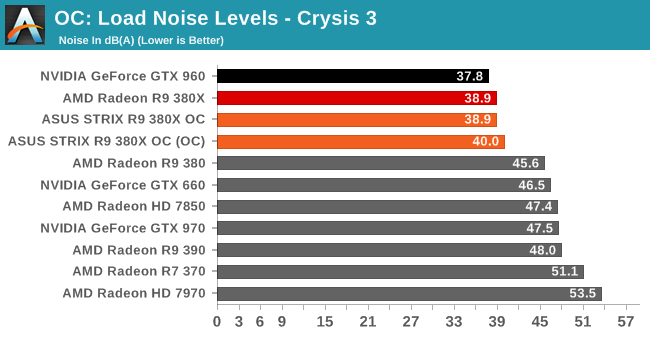
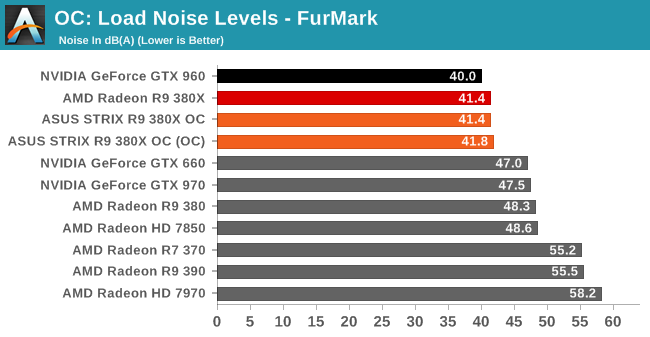
Since we can't overvolt, the power/temp/noise impact of overclocking is limited. Under gaming workloads the difference is a handful of watts and a nothing for temperature or noise. Otherwise FurMark, with the higher power target, pushes the STRIX card a bit harder, but everything still remains within reason.










101 Comments
View All Comments
Samus - Monday, November 23, 2015 - link
I had the Asus GTX970 Turbo and it had the grindiest ball bearing fan I've ever heard. It brought me back to the Athlon's YS Tech and Delta days. The "Titan" cooler on my old GTX770 was virtually silent in comparison.So Asus has their duds, but the Strix seems to be a great cooler if you don't need a blower...but many of us do. In a bit a shame toward Asus, I replaced their Turbo with a PNY 970 (also a blower) and the PNY feels cheaper, but cools better and makes less noise.
evilspoons - Tuesday, November 24, 2015 - link
Don't get me wrong here, I really like ASUS stuff - but they have let me down several times on cheapo video card cooling systems. Nasty sleeve bearing fans on half-height Radeon 6580s that vibrate then seize, which was really cheeky considering the box had a "high quality fan omg!!" thing as part of its marketing material.Ended up replacing the half-height card with a passively cooled one - and a nearby 80 mm case fan - so I couldn't have a crappy onboard fan, since every other card on the market seemed to be carrying the same stupid POS fan. I couldn't even spend more to get a better one!
Margalus - Monday, November 23, 2015 - link
I wouldn't get anything other than a EVGA cooling system.. I have the ACX 2.0 verions of a 970 and a 980 ti, and they are really fantastic... lolSamus - Tuesday, November 24, 2015 - link
EVGA is great, but they don't make Radeon cards. It's important to point out, as well, that EVGA is actually NOT NVidia's OEM partner. PNY is. PNY makes a ton of cards based off NVidia's reference designs, which I think are the best. The Titan cooler used on reference 770/780/970/980 GPU's, specifically the vapor-chamber variant, is unsurpassed by any other partners'. That's why almost every partner makes at least one variant of these GPU's with the Titan cooler. They don't make many, because the rumor is NVidia charges $30 for the vapor chamber cooler and it is more expensive to manufacture the cards because of the installation (GPU binding) technique.But EVGA has probably the best, easiest to deal with warranty. Unfortunately I've had to use it.
tamalero - Tuesday, November 24, 2015 - link
If use Sapphire's DualX and triX for the AMD camp imho.I'm still with my trusty 7950 dual X OC. and works wonders!
just4U - Friday, November 27, 2015 - link
From what I understand Sapphire started with the vapor chamber type cards on a few of their Radeons 6 years ago.. Interesting that Nvidia went that route. I'd never heard of any other company doing it before and didn't know they had that on their high end coolers..maecenas - Monday, November 23, 2015 - link
Fair enough, I am generalizing based on an observation pool of 2, which I shouldn't do, but I really enjoy having a silent GPU that doesn't go over 65C! It seems that cooling technology has progressed across the board, which is great news for everyone.BurntMyBacon - Tuesday, November 24, 2015 - link
@maecenasI agree they have a nice cooling system. They may even have the best at the moment. That said, I do believe they have some good competition in this area. MSI impressed me with their Twin Frozer design back before Asus had a DirectCU design out. They've been constantly improving since then. Saphire (much as I dislike them) released some very appealing vapor chamber designs. EVGA had pretty decent blower coolers, but nothing really standout until their second revision of their non-blower design (ACX 2.0). The ACX 2.0+ is copper heaven. I don't really favor designs that just throw another fan at it without really giving much thought to the heatsink design like Gigabyte's Windforce cards. I feel like MSI set the bar with their original Twin Frozer cards and since then, MSI, Asus, Saphire (sigh), and now EVGA have been vying for dominance in the cooling department.
just4U - Friday, November 27, 2015 - link
Strix is nice but MSI's cooling solution is just as good.olivaw - Monday, November 23, 2015 - link
Did I miss the GTX 960 review???